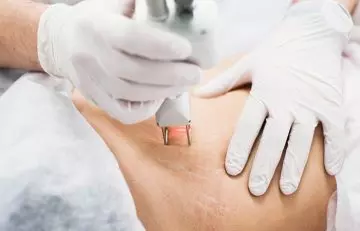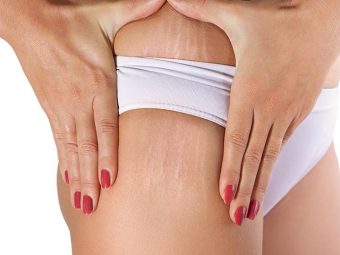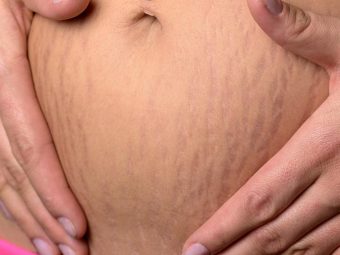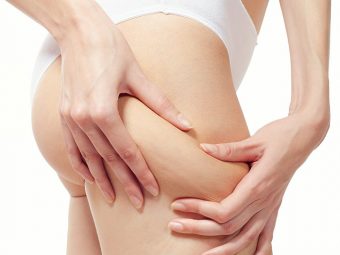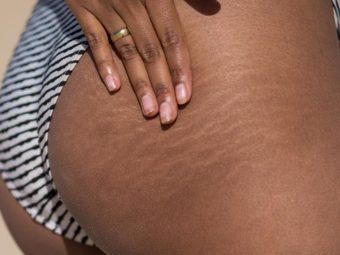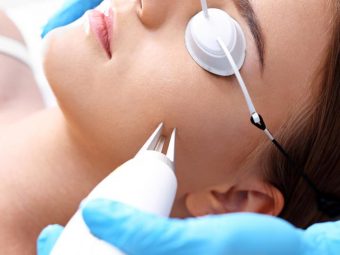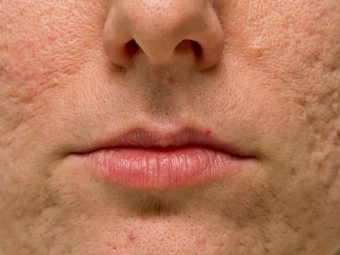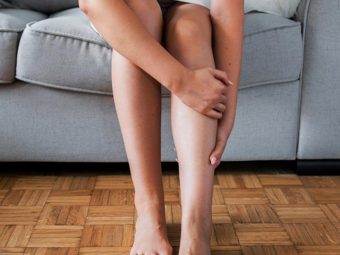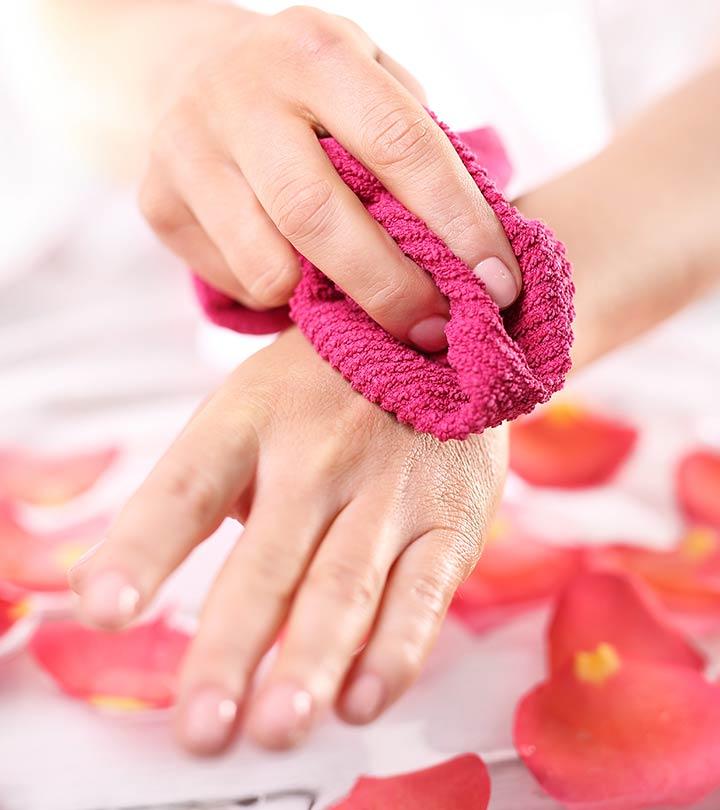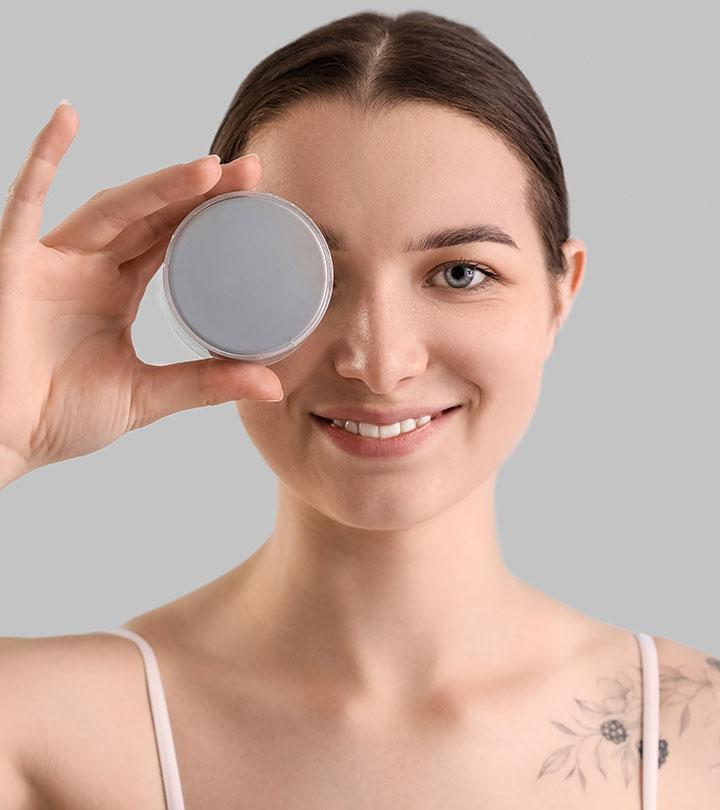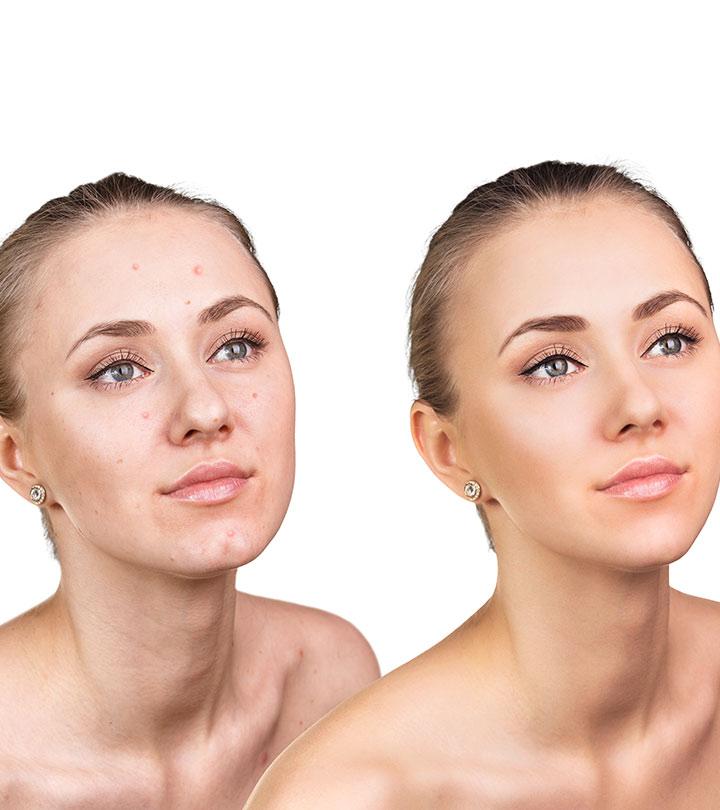Laser Stretch Mark Removal: Types, Cost, And How It Works
It is time to learn about the advanced treatment options to get rid of those stubborn streaks on your skin.

Image: Shutterstock
If you are hesitant to flaunt your body in a bikini due to stretch marks, you are not the only one. Well, it is high time you think about laser stretch mark removal. This procedure can help reduce scars and stretch marks, even though it cannot completely wipe them out.
If you are wondering how much a laser resurfacing treatment or laser therapy would cost and how safe it is, you have come to the right place. In this article, we have compiled some important information about this therapy that clears all your apprehensions and helps you make an informed choice. Have a happy read!
 Trivia
TriviaStretch marks are reported by approximately 50% and 90% of pregnant women and about 30% of adolescents going through puberty (11).
In This Article
How Do Stretch Marks Form?
Stretch marks form when the skin is stretched beyond its natural capacity, which causes the dermis to tear. This stretching can be a result of rapid weight changes, growth spurts, hormonal shifts, or genetic predisposition (1). This tearing leads to pink, red, or purple streaks or lines on the skin’s surface. However, these often fade to a lighter hue over time. Breasts, abdomen, upper arms, hips, and thighs are some common areas where stretch marks may develop. While they pose no health risks, their appearance may impact one’s self-esteem.
Laser therapy might be effective in reducing stretch marks. Learn more about it in the next section.
Is Laser Therapy Effective In Reducing Stretch Marks?
Skin rejuvenation and scar reduction are two common goals of cosmetic procedures in the field of aesthetic medicine. These procedures often involve promoting collagen production to improve skin texture and appearance. Laser therapy may help improve the appearance of stretch marks. However, the results are inconsistent.
This is because the results mostly depend on the severity of the stretch marks, skin type, and medical history (2). Laser therapy on two different skin types may not give the same results. However, it promises some improvement.
Lasers are intense monochromatic lights with different wavelengths. These are targeted on your skin to stimulate the fibroblasts (cells producing collagen and elastin). This boosts collagen and elastin production to cover up the stretch marks or scars (2).
According to research, stretch marks are more common in women than in men, and they are more noticeable in people with darker skin. The prevalence of striae varies from 6% to 86% during puberty, and it is 43% during obesity. Additionally, there is a higher prevalence among people with a larger abdominal area and weight gain.
Keisha, a YouTube vlogger, shared her experience about getting laser treatment done to remove stretch marks on her belly. She said, “My stomach feels a little bit weird, it just feels like it’s been pricked with like needles a lot but not, not mad needles, that kind of blunt needles…it’s not bad, the pain’s definitely tolerable (i).”
Collagen and elastin are crucial parts of the basic structure of your skin. They give strength, structure, and elasticity to the skin. Most treatment options for stretch marks, including laser therapy, focus on collagen and elastin production. In the next section, let’s understand how the different types of lasers can help reduce stretch marks.
How Does It Work? What Are The Types Of Lasers Used For Stretch Marks?
Two types of lasers are used for treating stretch marks:
- Ablative Lasers: These lasers have a wavelength above 1000 nm. The water in your skin tissues can absorb ablative lasers easily. As a result, the tissues heat up and are remodeled. The most common ablative lasers used for treating stretch marks and scars are CO2 (10,600 nm) and Er.YAG (2940 nm) lasers.
- Non-Ablative Lasers: These lasers are as effective as ablative lasers. However, compared to ablative lasers, non-ablative lasers are well-tolerated and patient-friendly. Common non-ablative lasers used for treating stretch marks include Erbium glass (Er glass 1540 nm), pulsed dye laser, Nd: YAG 1064 nm, and 308nm Excimer laser.
Here’s what research has to state about the efficacy of lasers for stretch marks:
1. Fractional CO2 Laser
Six women (between ages 20 and 35 years) with stretch marks were treated with a 1550 nm FP laser.
After eight weeks, the results were evaluated, and the study noted a substantial improvement in their stretch marks (3) (2). The study also noted an increase in epidermal thickness, collagen, and elastin levels.
2. Pulsed Dye Laser
A study evaluated the effect of a 585-nm flash pump-pulsed dye laser to treat stretch marks on patients between the ages of 23 and 52 years. The study used lasers of different energy densities.
They found that treating stretch marks (10 mm spot) using 3.0 J/cm2 fluence improved the appearance of the marks better than lower frequencies of laser (4).
3. Excimer Laser
While other lasers focus on promoting collagen and elastin production for treating stretch marks, this laser focuses on repigmentation.
Several studies found that Excimer laser could improve the appearance of stretch marks by re-pigmenting the area. However, it needs multiple sessions to show results (2).
4. Erbium Laser (1550-nm)
This non-ablative fractional laser (NAFL) helped to improve the stretch marks in 16 patients who developed abdominal stretch marks following pregnancy.
The width of the stretch marks decreased from 6.94 mm to 3.25 mm at the first follow-up visit and to 3.13 mm at the second follow-up visit. The length of the stretch marks decreased from 6.06 cm to 2.88 cm at the first follow-up visit and 2.75 cm at the second follow-up visit (5).
5. Nd: YAG Laser
A study used Nd: YAG lasers in two different intensities for striae alba (white stretch marks) and striae Rubra (red stretch marks). The study reported improvement in white stretch marks at a higher energy of 100 J/cm2 and red stretch marks with a lower intensity of 75 J/cm2.
The results were evaluated after four sessions and on 45 patients between the ages of 11 and 36 years with Fitzpatrick skin typesi XA scientific skin tone scale used to classify skin coloring and skin’s response to ultraviolet radiation of the sun. III-IV (6).
6. Er: YAG Laser
Er: YAG laser (2940- nm) showed clinical improvement in treating stretch marks when combined with rb-bFGF (recombinant bovine basic fibroblast growth factor).
Thirty subjects with white stretch marks were treated with Er: YAG laser six times with four-week intervals and then treated with rd-bFGF spray for a week at home. After that, they received a light-emitting diode-red light (LED-RL) treatment once every seven days (three sessions).
At the end of the study, researchers found improvement in stretch marks, epidermal and dermal thickness, and collagen and elastin density (7).
Doctors often use a single laser or a combination of lasers or a combination of laser and other treatment methods to treat stretch marks. The method employed depends on the degree of severity of your stretch marks and your skin type. If you are wondering how much laser therapy for stretch marks may cost, check out the next section.
How Much Does Laser Stretch Marks Removal Cost?
As per the 2016 Cosmetic Surgery National Data Bank Statistics by The American Society of Aesthetic Plastic Surgery, a physician or surgeon may charge $2681 for laser skin resurfacing treatment. That’s the national average (8).
However, the costs may vary, depending on the severity of your stretch marks and the number of sessions you may need. It may also depend on whether you need a combination of treatments or not.
Usually, early and fresh stretch marks respond well to treatment and may need fewer sessions compared to striae alba or white stretch marks (the old ones).
Moreover, not all lasers have the same effect on all skin types. The doctor needs to evaluate every aspect before starting your treatment, and only then you may understand how much it is going to cost you. It is better to consult a doctor to get a complete idea.
Do the results may last or not? Find out next.
How Long Does The Effect Last?
The results of laser treatment for stretch marks may not be permanent, and you may need follow-up treatments for maintaining the results.
According to the American Academy of Dermatology Association, you may need to undergo a series of follow-up therapies for lasting results (9).
While laser treatment for stretch mark removal seems promising, there are side effects that you should be aware of.
Are There Any Side Effects Of Using Laser For Stretch Marks?
You may experience a few side effects right after undergoing laser resurfacing therapy for stretch marks. They include:
- Post-treatment erythema (Redness due to inflammation) (2)
- Edema (water retention in tissues) (2)
- Dyschromia or change in skin color (2)
- Hyperpigmentation (especially in people who tan easily) (10)
Right after the treatment, you may notice redness. But that is common and goes away in a few days. In case you experience any of the above symptoms, consult your doctor.
Apart from laser therapy, there are other treatment options for stretch marks that you might want to explore.
What Are The Other Treatment Options?
Your doctor may suggest several treatment options (other than laser therapy) after evaluating your skin, stretch marks, and medical history. The common treatment methods include:
- Microdermabrasioni XA minimally invasive cosmetic procedure that gently exfoliates the skin to improve the overall skin tone, condition, and texture.
- Microneedling
- Chemical peelingi XA procedure involving topical application of a chemical solution to exfoliate the top layer of the skin and improve its appearance.
- Retinoids and ointments
 Quick Tip
Quick TipAn anti-stretch mark cream made of good emollients and moisturizers, such as hydroxyprolisilane Ci XA major component of protein and collagen often used in various anti-aging skin care and lip care products. , rosehip oil, Centella asiatica triterpenesi XA compound with skin healing properties like speeding up wound closure, reducing scarring, preventing oxidative stress, etc. , and vitamin E, can help reduce and prevent the appearance of stretch marks (12).
They may also combine laser therapy with other treatment options after evaluating your skin condition.
Infographic: Things To Consider Before Getting Laser Therapy For Stretch Marks
Laser treatment for stretch mark removal appears magical at first glance and is largely effective. However, the procedure isn’t always suitable for everyone, and the results may differ. Moreover, you must consider a few practical concerns before opting for the procedure. See the infographic below to learn more. Illustration: StyleCraze Design Team
Laser stretch mark removal is considered an effective treatment option to fade stretch marks. If you have severe or old stretch marks, you may opt for laser treatment. However, consult a doctor to determine your suitability for the treatment and understand its pros and cons. They can guide you about the results to expect, aftercare procedures, and what else can be done to improve their appearance (combinations therapy). This will help prevent unwanted side effects and other complications and ensure that you get the best results.
Frequently Asked Questions
Is laser treatment for stretch marks safe?
Yes, laser treatment is a non-invasive, long-lasting and safe treatment for improving the appearance of stretch marks with minimum risk of injury.
Is microneedling or laser better for stretch marks?
Both microneedling and laser are safe and effective treatments for stretch marks. Consult your dermatologist to understand the best treatment suitable for you.
Is laser treatment for stretch marks painful?
No. Although you may feel a subtle tingling sensation, the pain level in laser treatment is tolerable.
How long does it take to see results from laser stretch mark removal?
It may take around 3 to 6 months to see visible improvement.
Does laser stretch mark removal work on dark skin?
Yes, it works on all skin tones.
Key Takeaways
- Laser therapy aims to increase collagen and elastin production while concealing stretch marks and scars.
- The effects of laser treatment for stretch marks may not be permanent, and you may require follow-up treatments to preserve the benefits.
- However, the cost will vary depending on the severity of your stretch marks and the number of treatments required. It may also be determined by the mix of treatments you require.
- You may experience a few side effects right after undergoing laser resurfacing therapy for stretch marks. These can include post-treatment erythema, edema, dyschromia, or hyperpigmentation.
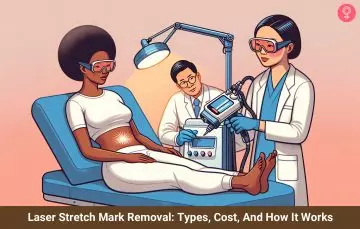
Image: Stable Diffusion/StyleCraze Design Team
Curious about laser stretch mark removal? Witness the step-by-step procedure of the first session in this enlightening video. Get ready to say goodbye to those marks! Watch now and embrace smoother skin.
Personal Experience: Source
StyleCraze's articles are interwoven with authentic personal narratives that provide depth and resonance to our content. Below are the sources of the personal accounts referenced in this article.
i. LASER STRETCH MARK Removal VLOG|| Pulse Light Clinichttps://www.youtube.com/watch?v=ywRQQdM2vHo
References
Articles on StyleCraze are backed by verified information from peer-reviewed and academic research papers, reputed organizations, research institutions, and medical associations to ensure accuracy and relevance. Read our editorial policy to learn more.
- Oakley, Amanda M. and Patel, Bhupendra C. “Stretch Marks” StatPearls
https://www.ncbi.nlm.nih.gov/books/NBK436005/ - Lokhande, Archana J, and Venkataram Mysore. “Striae Distensae Treatment Review and Update.” Indian dermatology online journal vol. 10,4 (2019): 380-395. doi:10.4103/idoj.IDOJ_336_18
https://www.ncbi.nlm.nih.gov/pmc/articles/PMC6615396/ - Kim, Beom Joon et al. “Fractional photothermolysis for the treatment of striae distensae in Asian skin.” American journal of clinical dermatology vol. 9,1 (2008): 33-7. doi:10.2165/00128071-200809010-00003
https://pubmed.ncbi.nlm.nih.gov/18092841 - McDaniel, D H et al. “Treatment of stretch marks with the 585-nm flashlamp-pumped pulsed dye laser.” Dermatologic surgery : official publication for American Society for Dermatologic Surgery [et al.] vol. 22,4 (1996): 332-7. doi:10.1111/j.1524-4725.1996.tb00326.x
https://pubmed.ncbi.nlm.nih.gov/8624657 - Gokalp, Hilal. “Long-term results of the treatment of pregnancy-induced striae distensae using a 1550-nm non-ablative fractional laser.” Journal of cosmetic and laser therapy : official publication of the European Society for Laser Dermatology vol. 19,7 (2017): 378-382. doi:10.1080/14764172.2017.1342040
https://pubmed.ncbi.nlm.nih.gov/28665161 - Elsaie, Mohamed L et al. “Comparison of the effectiveness of two fluences using long-pulsed Nd:YAG laser in the treatment of striae distensae. Histological and morphometric evaluation.” Lasers in medical science vol. 31,9 (2016): 1845-1853. doi:10.1007/s10103-016-2060-2
https://pubmed.ncbi.nlm.nih.gov/27595152 - Shen, Jie et al. “Combination of a 2940 nm Er:YAG laser with recombinant bovine basic fibroblast growth factor (rb-bFGF) and light-emitting diode-red light (LED-RL) for the treatment of striae alba: A pilot study.” Journal of cosmetic dermatology vol. 17,2 (2018): 176-183. doi:10.1111/jocd.12376
https://pubmed.ncbi.nlm.nih.gov/28755402 - 2016 Cosmetic Surgery National Data Bank Statistics, The American Society of Aesthetic Plastic Surgery.
https://www.surgery.org/sites/default/files/ASAPS-Stats2016.pdf - “10 Things to Know before Having Laser Treatment for Your Scar.” American Academy of Dermatology.
https://www.aad.org/public/cosmetic/scars-stretch-marks/laser-treatment-scar - Ramsdell, William M. “Fractional CO2 Laser Resurfacing Complications.” Seminars in plastic surgery vol. 26,3 (2012): 137-40. doi:10.1055/s-0032-1329415
https://www.ncbi.nlm.nih.gov/pmc/articles/PMC3580977/ - Perception of Stretch Marks Risk Factors Among Adults in Riyadh, Saudi Arabia
https://www.ncbi.nlm.nih.gov/pmc/articles/PMC8671049/ - Use of a specific anti-stretch mark cream for preventing or reducing the severity of striae gravidarum. Randomized, double-blind, controlled trial
https://pubmed.ncbi.nlm.nih.gov/23237514/





